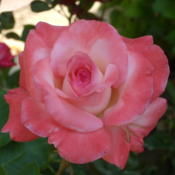Cognition
Tips for Smart Gardeners
A thinking person's guide to getting more from that healing hobby.
Posted January 20, 2018

This is part of a series of tips for smart people. The others are:
Five Tips for Smart People in a Not-So-Smart World
Seven Money Tips for Smart People
Five Learning Tips for Smart Adults
Nine Time Management Tips for Smart People
Seven Stress Management Tips for Smart People
Five Tips for Smart Job Seekers
Four Dating Tips for Smart People
Ten Tips for Parents of a Smart Child.
Gardening is among our most psychologically rewarding recreations: seeing the miracle of growth while getting outdoor exercise.
Gardening is the everyperson’s hobby. So most of the gardening advice is aimed at the grand middle. The following suggestions are for people who’d like to use an above-average amount of noggin. The ideas may also be useful to horticultural therapists.
Selecting plants wisely
Your subjective preferences may end up trumping all other factors, but a rational consideration of what to grow involves deciding, over the plant’s lifespan, the plants that will yield you the most pleasure for the effort and cost expended. Subsumed in that might be:
- Bloom form. For example, many people consider a spiral-centered hybrid tea rose the most beautiful flower. See the photo of Sheer Elegance above.
- Percent annual attractiveness: The theoretical maximum is that 100% of the plant is attractive 100% of the year. The minimum is that just a tiny bit of the plant is attractive for just a few days a year. One example of a high-attractiveness plant, at least in frost-free, Oakland, California where I live is an orange tree: During the two months it’s in fruit, you have attractive oranges dotting the tree. For another month, it’s in bloom, liberally laced with white, fragrant flowers. When not in fruit or flower, for the entire rest of the year, as an evergreen, it’s still always covered with lush deep green foliage and a plant habit that is classic tree-like: solid trunk, rounded symmetrical canopy.
Plants that have high annual attractiveness in all parts of the country include annuals such as marigold or zinnia for sun, impatiens for shade. All those have the additional bonus of being easy-care and cheap--You can get a six-pack for a few dollars.
- Amount of care required. For example, before planting, roses require you to dig out an 18” cube of soil and replace a third of it with compost plus bone meal. Plus, roses require one major and two or three minor thorny prunings during the year. In contrast, a Japanese maple requires virtually no pruning.
I happen to enjoy pruning enough that I have a few roses in my garden—Of course, I live in the San Francisco Bay Area where roses bloom nine months out of the year. In most parts of the U.S., roses bloom for just a few months and are more subject to disease. Unless your idea of fun is wearing a spray mask and releasing pesticides and fungicides into the environment, avoid plants that need to be sprayed, for example, apple, cherry, and peach trees.
Most roses require spraying but I choose disease-resistant yet gorgeous varieties which, without spraying look darn good, for example, Sheer Elegance and Black Magic, but the roses in my garden won’t be winning any rose shows—The price of perfection is too great for most recreational gardeners including me.
- Food value. Except for tomatoes, a plant’s food value usually should be a minor consideration: Relative to the effort, the taste and/or cost-saving versus store-bought is too small.
- Cultivar selection. There’s great variation within a species. For example, with tomatoes, traditionalists value the naturally occurring heirlooms, the most popular of which are Brandywine and Cherokee Purple. Most people, however, prefer to grow hybrid varieties because of their greater yield and disease resistance, many of which taste as good or better than most heirlooms. Examples: the large-fruited Big Beef and the cherry tomato Orange Paruche.
Many thinker types find it fun to read lots of reviews and assess pros and cons of various varieties. Start with the product descriptions and buyer reviews on popular seed websites, which have a large enough user base to provide a decent number of reviews. Also, the larger sites tend to have enough of a research team to have carefully curated varieties. I use ParkSeed.com and HarrisSeeds.com and, for my specialties of interest, a specialty site, for example, TotallyTomatoes.com, ReganNursery.com for roses, and violetbarn.com for African Violets, which is a houseplant that blooms much of the year with little effort. Before buying, I’ll typically look for additional user reviews using a Google Search. I find that fun.
Care
Increase your pleasure-to-effort ratio by being efficient in watering and feeding. An automatic watering system, usually consisting just of a low-cost plastic drip system, timer, and a fertilizer injector such as this Ez-Flo saves enormous time. The specific fertilizer usually isn’t critical—A balanced fertilizer used on all your plants gets you almost as good a result as using different fertilizers for different plants. The pH is most soils is fine for most plants but a few plants like blueberries, azaleas, and rhododendron like acid soil, so if you want to grow those, it's minimal additional work: Just use any of the readily available acid fertilizers.
Hybridizing
After a while, many gardeners lament a particular plant’s liabilities. That was true of me with roses. They are a nine-month-a-year flower factory but they’re prone to fungal diseases. So I decided to try my hand at hybridizing roses for disease resistance. I didn’t take any courses, I simply read a booklet, Rose Hybridizing for Beginners, dug up an article on hybridizing roses for disease resistance, visited two hybridizers to see what they do first-hand and ask questions, and, within a month, had started crossing the best compact disease-resistant varieties with the varieties that were best overall: prettiest flower and best annual attractiveness---the beautifully formed deep red miniature roses you can get at the supermarket. I evaluated the seedlings and submitted the best to a rose wholesaler. Three of my varieties are now in commerce and I get a royalty check each year. I’ve since stopped hybridizing but if I were to continue, I’d probably take the best of the seedlings and cross them again with a healthy compact high-quality rose with 15-20 petals such as Peachy Knockout, Flower Carpet Scarlet, and Coral Drift. I’d also make some crosses between my two best seedlings.
The takeaway
All careers and avocations can be done at various levels, from minimally to quite intellectually challenging. This article’s purpose was to fill the gap in the literature by offering tips for the brainy gardener. Hope you enjoy.
I read this article aloud on YouTube.




